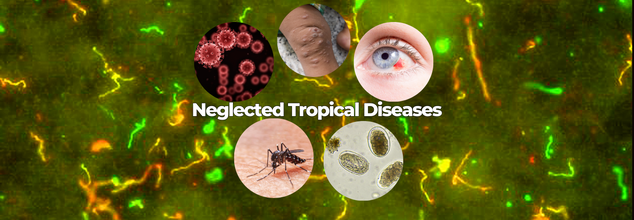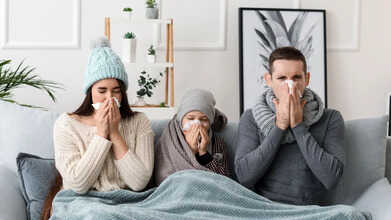- Health Conditions A-Z
- Health & Wellness
- Nutrition
- Fitness
- Health News
- Ayurveda
- Videos
- Medicine A-Z
- Parenting
Over 1 Billion People Worldwide Suffer From Neglected Tropical Diseases- Know All About The Illness

Image Credit: Canva
Neglected Tropical Diseases (NTDs) impact over one billion people worldwide and affect poor and marginalized communities the most. Infectious diseases, including bacteria, viruses, fungi, parasites, and toxins, lead to extreme health complications like blindness, developmental problems, and chronic disabilities. Because of this heavy burden, NTDs get less attention and resources, thus worsening the already challenging economic and healthcare scenarios in these regions.
The World Health Organization has classified 21 different conditions as NTDs. These diseases mainly thrive in tropical and subtropical climates and are linked to poor sanitation, lack of clean water, and inadequate healthcare infrastructure. Unlike other infectious diseases, NTDs have been largely ignored by the pharmaceutical industry due to their concentration in low-income populations, making treatment and prevention efforts even more challenging.
Although progress has been achieved in controlling some NTDs through global health initiatives, for instance dengue, much more is needed to eradicate them completely. This requires collaboration among governments, healthcare organizations, and the pharmaceutical industry to develop low-cost treatments, expand vaccination programs, and improve sanitation in high-risk areas.
Common Types of Neglected Tropical Diseases
NTDs range from mild to severe, and permanent disability or even death can occur, according to the NIH. The most common of these are the following:
Ascariasis
This NTD is caused by the roundworm Ascaris lumbricoides. This infection is found mainly in places where sanitation is very poor. Though most people have no symptoms at all, more serious cases cause extreme pain in the abdominal region, vomiting, and sometimes even death.
Buruli Ulcer
Caused by a bacterium, Mycobacterium ulcerans, Buruli ulcer results in painful ulcers on the skin, which if not treated can extend into the bones, leading to permanent disability.
Chagas' Disease (American Trypanosomiasis)
Distributed through blood-feeding "assassin bugs," this parasitic disease may lead to swollen lymph nodes and even fatal damage to the organs if not treated.
Dengue Fever
A mosquito-borne viral infection, dengue fever causes high fever, joint pain, and in severe cases, hemorrhagic fever leading to shock and death.
Leprosy (Hansen's Disease)
Caused by Mycobacteria, Leprosy results in nerve damage with severe disfiguring effects of the condition that leaves individuals greatly stigmatized.
Lymphatic Filariasis (Elephantiasis)
Spread by mosquitoes, this parasitic disease results in painful swelling of the limbs and genitals with increasingly severe disabilities, leading to gross disfigurement.
Onchocerciasis (River Blindness)
This parasitic disease, which is transmitted by black flies, causes severe itching, skin lesions, and permanent blindness.
How Do NTDs Affect Health?
According to Dr. Vivek MS, MBBS MD Microbiology, "NTDs disproportionately affect the world's poorest communities, leading to chronic illness, disability, and social stigma. Despite their devastating impact, these diseases do not receive adequate attention compared to other global health issues."
NTDs contribute to a cycle of poverty by impairing children's development, reducing adult productivity, and burdening healthcare systems. Conditions such as malnutrition, poor education, and limited access to medical care further exacerbate their impact, making it difficult for affected populations to escape poverty.
Preventive Measures To Adopt
Hygiene and Sanitation
Dr. Vivek MS says, "Improving hygiene and sanitation is one of the most effective ways to prevent NTDs. Access to clean water and proper sanitation facilities can significantly reduce the transmission of diseases like cholera, trachoma, and soil-transmitted helminths."
Vaccination
Vaccination is a critical tool in preventing diseases such as dengue and yellow fever. Large-scale immunization programs help protect vulnerable populations and reduce the spread of infection.
Awareness
Community education plays an important role in controlling NTDs. "Information on causative agents, symptoms and prevention of NTDs promotes behavioral changes in improved health practice, and early intervention," said Dr. Vivek MS.
Healthcare Systems Strengthening
Access to healthcare should be scaled up and expanded to the regions affected. Investments in local healthcare infrastructure, staff capacity building, and reasonably priced medicines can greatly reduce the burden of NTDs.
Dr Vivek MS is a MBBS MD with specialisation in Microbiology at Apollo Spectra Hospitals, Bangalore in India
Bemotrizinol: FDA Proposes New Sunscreen Ingredient—Here’s Why It Matters

Credits: Canva
America is aiming to align with global trends in sun protection. On December 11, the Food and Drug Administration proposed allowing the use of bemotrizinol in sunscreens — an ingredient that has been widely used in other countries for years.
Bemotrizinol provides stable, long-lasting defence against both types of UV rays that can harm the skin. According to the FDA announcement, it is gentle enough to be safe for young children and could be on shelves in time for next summer.
"The agency has historically moved too slowly in this area, leaving Americans with fewer options than consumers abroad. We’re continuing to modernize the regulation of sunscreen and other over-the-counter drug products,” FDA Commissioner Marty Makary said in a press statement. “Americans deserve timely access to the best safe, effective, and consumer-friendly over-the-counter products available.”
What is Bemotrizinol?
Bemotrizinol, also called BEMT, is a chemical that absorbs both UVB and UVA rays. If those terms sound familiar, it’s likely because you’ve seen them on nearly every sunscreen bottle. The sun emits ultraviolet (UV) radiation, which is exactly what sunscreen is designed to block.
UVB and UVA describe different kinds of rays, according to the University of Texas MD Anderson Cancer Center. For our skin, the difference isn’t huge. UVA causes tanning and burns faster than UVB, while UVB can be partially blocked by barriers like windows or clouds.
About 95% of UV reaching the ground is UVA, with UVB making up the remaining 5%, according to the Anderson Cancer Center. Sunscreens work in two ways: creating a physical barrier with minerals or using chemicals that absorb rays before they reach the skin. BEMT falls into the latter category.
Why Is BEMT Good For Use In Sunscreen?
BEMT ticks many boxes for an effective sunscreen ingredient. It is broad-spectrum, shielding against both UVA and UVB, and achieves higher SPF protection in smaller amounts than some other popular chemicals, according to Certified Laboratories and the FDA via USA Today. It is also photostable, meaning it breaks down more slowly when exposed to sunlight, and being oil-soluble makes it easy to mix into creams.
The ingredient is minimally absorbed into the body through the skin and rarely causes irritation, which is why the FDA considers it safe for children as young as six months old.
When Will BEMT Come To Sunscreen In The US?
Following the proposal, the FDA has opened a 45-day public comment period. Once the agency reviews feedback and confirms safety, it will issue a final order to allow the ingredient. Over-the-counter approvals are generally faster than the one-to-two years typical for prescription drugs. The FDA told Today that BEMT sunscreens could be available by summer or fall of 2026.
What Caused FDA Delays in Sunscreen Approvals?
Recent holdups at the U.S. Food and Drug Administration in clearing new sunscreen ingredients have largely stemmed from long-standing regulatory slowdowns, which left American shoppers with fewer choices than those offered in many other countries.
The agency’s plan to permit the use of bemotrizinol, a filter already common abroad, marks a step toward updating its approach to sunscreen oversight and giving people access to more advanced formulas. Updates from the agency note that bemotrizinol delivers steady, broad-spectrum defense against UVA and UVB rays and is mild enough for children, bringing U.S. standards closer to what is widely available worldwide.
As Super Flu Cases Rise, Doctors Explain Whether Ibuprofen Or Paracetamol Works Better For Symptoms

Credits: Canva
As a strong wave of “superflu” and other seasonal infections moves through the country, large numbers of people have fallen ill this winter. The rise has been serious enough for some NHS officials to advise anyone with symptoms to wear a mask. Newly released data shows how quickly the situation has worsened, with flu admissions jumping by 55 percent in a single week.
This sharp climb has pushed the NHS into what leaders describe as a “worst case scenario” for December. As per The Independent, over the past week, hospitals saw an average of 2,660 daily admissions for flu, the highest figure ever recorded at this point in the year. With so many people under the weather, many are trying to work out which pain reliever offers better comfort. An expert previously spoke to the Mirror on this exact point.
Superflu Cases Rise In UK
Figures released today highlight the severity of the situation, with flu hospitalisations having surged by more than half (55%) in just one week. This massive increase has officially plunged the NHS into a "worst case scenario" situation for the month of December. Last week, an average of 2,660 patients per day were admitted to hospital beds with flu, marking the highest number ever recorded for this time of year.
Superflu Cases: What To Take Paracetamol Or Ibuprofen?
With so many people falling poorly, it can be helpful to know which medicine is best to take. Thankfully an expert previously spoke to the Mirror about ibuprofen and paracetamol. Abbas Kanani, the superintendent pharmacist at Chemist Click, said: "Paracetamol is probably more effective at bringing down temperature, so it's almost like a double-whammy, you get rid of your headache and bring your temperature down. "But if you feel that you have more body aches, that's your main symptom, then ibuprofen is probably slightly better as it's an anti-inflammatory."
However, he cautioned users to be mindful of potential allergies to ibuprofen, which belongs to a specific class of drugs.
He also revealed that many people are unaware that they can actually take both medicines together when feeling particularly unwell. "If you feel that one isn't enough you can take ibuprofen as well as paracetamol, you can take them together. A lot of people don't know that it's not one or the other, you can put them together as they work in different ways."
While these two medications can alleviate aches, pains and fevers, as well as mild cold and flu symptoms, Abbas notes that they won't be particularly effective for those struggling with coughs and nasal congestion.
To address these specific symptoms, you'd need to utilise cold and flu products instead.
Choosing Medicine Based on Your Symptoms
Many people assume one medicine works better for all flu complaints, but the expert’s guidance shows that the right choice depends on what you’re feeling. Fever and headache respond more readily to paracetamol, while body aches and inflammation may ease faster with ibuprofen. For coughs or blocked sinuses, cold-and-flu formulas are needed because standard pain relievers do not target those issues.
Top 10 Weird But Medically Valid STI Questions People Asked On Reddit In 2025

Credits: Canva
Public forums often turn into places where people share worries they hesitate to bring up with a doctor. Reddit, especially, saw a surge of unusual yet genuinely important questions about sexually transmitted infections this year in 2025. A large number of these posts came from young adults who felt unsure about new symptoms, confused about how infections spread or overwhelmed by the flood of sexual-health content circulating online.
The ten questions below may seem odd at first glance, but each one raises a medically sensible point. Together, they show how gaps in sexual-health awareness still shape the way people talk about intimacy and illness on the internet.
What Is An STI?
STI refers to a Sexually Transmitted Infection. It is an infection passed through sexual activity such as oral, vaginal or anal contact, and in some cases through non-sexual routes such as blood exposure or mother-to-child transmission.
These infections can be caused by bacteria, viruses or parasites. Some lead to clear symptoms while others remain silent, but untreated cases can result in serious health problems. When an STI begins to cause notable medical issues, it is often described as a Sexually Transmitted Disease (STD).
Top 10 Weird But Medically Valid STI Questions People Asked On Reddit
“Is it possible to get an STI if both people are virgins?”
One user who had only engaged in oral and anal sex with another virgin noticed marks on their legs and wondered if infections could be “passed down by parents.” The spots disappeared on their own, likely due to shaving irritation, yet the question reveals a common misconception. STIs cannot be inherited genetically. They require actual transmission through sexual contact, blood or childbirth.
“Can kissing, a blowjob or rimming spread an STI?”
This question came from someone who had watched too many alarming clips about PrEP and safe sex on social media. They became so uneasy that they avoided going on dates until they understood the risks. Some infections can spread through oral sex and deep kissing, though the degree of risk varies. Their fear felt intense, but the doubt itself was completely reasonable.
“Has anyone in Sri Lanka even had an STI?”
A user in a regional subreddit asked whether STIs even “exist here” because no one talked about them openly. The framing sounded odd, but it reflected the silence that still surrounds sexual health in many places. STIs appear everywhere, though in some communities the subject is rarely discussed.
“What is the real STI risk from a glory hole?”
One of the year’s most unusual but earnest threads came from someone trying to understand whether anonymous sexual setups increase risk. They asked about skin-to-skin contact, bodily fluids and the impact of poor visibility. Though the question seemed strange, experts often point out that uncertainty about partners and surroundings can raise the chance of exposure.
“For people who use glory holes, aren’t you worried about getting an STI?”
Another thread took a more confrontational tone, suggesting that anyone who uses a glory hole “either already has an STD or doesn’t care.” Replies pushed back, saying that anonymity has many motives and that what truly matters is the use of protection and clarity about risk, not assumptions about a person’s character.
“Would I break up with a new partner if they gave me an STI?”
This question was framed like a moral dilemma, but the situation involved real medical timing. A woman had contracted an STI from a partner who had tested too early for the infection to show up on his results. One commenter suggested that the timing hinted at sexual activity very close to the start of their relationship. The discussion blended relationship boundaries with the science of incubation periods.
“I have every symptom under the sun. Is this an STI?”
A worried user described swollen tonsils, tiredness, muscle twitching, stomach cramps, cracking joints, night sweats and more. None of this lined up with any single STI, yet their panic was sincere. The thread showed how anxiety can turn normal bodily sensations into something that feels catastrophic.
“Could I have an STD from giving oral once?”
A person who had their first sexual experience by giving oral sex to an AFAB partner developed painful cracks on their genitals a few days later, even though there was no genital contact. They feared they had caught an infection. While genital cracks from oral contact alone are unlikely, some infections can move through oral-genital routes. Their confusion made sense even if the symptoms did not match the exposure.
“Are these rashes from sex or something else entirely?”
Several users described bumps, redness and irritation, convinced they must have an STI. Many replies explained that chafing, sweat, allergic reactions or grooming habits can look similar to infection symptoms.
“My symptoms came weeks later. Could it still be an STI?”
Some posters were puzzled when new bodily changes appeared long after a sexual encounter. They mentioned stomach issues, headaches or tiredness. While certain infections do have incubation windows, many unrelated issues can appear around the same time, which can lead people to make the wrong connection.
These questions may sound strange, but nearly all came from people trying to understand their bodies and risks. They also show how much sexual-health education remains incomplete. Proper testing, routine medical visits and clear conversations with professionals are still far more dependable than guessing through anonymous internet threads.
© 2024 Bennett, Coleman & Company Limited

